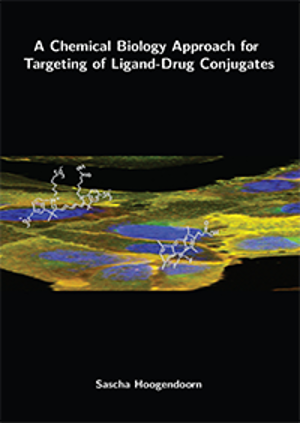Proefschrift
A chemical biology approach for targeting of ligand-drug conjugates
Promotores: H.S. Overkleeft, G.A. van der Marel, Co-Promotor: R.G. Boot
- Auteur
- S. Hoogendoorn
- Datum
- 23 januari 2014
- Links
- Thesis in Leiden Repository

Cells express a large array of membrane receptors on their surface that function as a communication channel between the extra- and intracellular environment of the cell. Ligands for these receptors span a wide range of biomolecules, from proteins to carbohydrates to small molecules. Some receptors are continuously recycling between the membrane and the inside of a cell, whereas others are in a steady-state at the membrane and need ligand binding for their activation and subsequent internalization. Synthetic molecules that bind to these membrane receptors can be used to either modulate their function, or to target a reporter group (i.e. a fluorescent dye) and/or a bio-active compound (drug, protein) to cells that express this receptor, ensuring delivery to a specific cell-type. The research described in this Thesis combines synthetic and biochemical methodologies to create ligands that interact selectively with membrane receptors of the GPCR and lectin-binding families. Attachment of synthetic probes, proteins or cytostatic molecules to these ligands by a variety of chemical and enzymatic methods ensured their uptake exclusively into cells that expressed the receptor of interest. Visualization of this process was enabled by the incorporation of a fluorescent dye into the final constructs.
